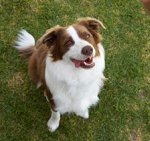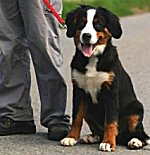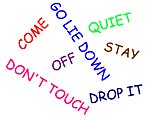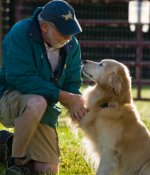Italian Greyhounds: What's Good About 'Em, What's Bad About 'Em
Italian Greyhound temperament, personality, training, behavior, pros and cons, advice, and information, by Michele Welton, Dog Trainer, Behavioral Consultant, Author of 15 Dog Books
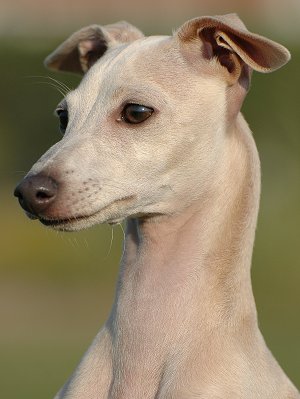
The Italian Greyhound is sweet-natured and gentle, yet also exceptionally playful and athletic.
This warmth-seeking, comfort-loving dog can usually be found basking in sunspots or snuggled into soft furniture, often hidden under a blanket, pillow, or towel. When you own an Italian Greyhound, you need to watch where you sit!
But if this breed sounds like the perfect couch potato . . . he isn't! In between his placid snuggles, Italian Greyhounds will suddenly explode into a burst of vigorous running and leaping, tearing pell-mell around the house or yard, darting and zigzagging at breakneck speeds and literally bouncing off the walls, fence, sofa, or beds.
Perching themselves up high on the back of your sofa to better see out the window, young Italian Greyhounds are notorious for breaking their long fragile legs as they launch themselves fearlessly into space and crash to the floor. Their spurts of reckless abandon can be nerve-wracking to live with!
The same is true outdoors. A yard that hopes to contain an Italian Greyhound should have a high (at least six-foot fence), because this racy, agile breed is a fantastic jumper. Off-leash walks would be foolish for a similar reason: he can be out of sight in seconds.
Polite (often a bit aloof) with strangers, there is potential for timidity, so he should be socialized early and thoroughly.
The Italian Greyhound is amiable with other dogs and cats, but some have a high prey drive and will run squeaky creatures into the ground.
IGs (pronounced eye-jees) or Iggies are mildly stubborn and very sensitive. They respond favorably only to gentle, upbeat training methods that emphasize cheerful praise and food rewards. Physical corrections should be gentle and fair, as these dogs can be "touch-sensitive".
Italian Greyhounds have marvellously quirky, inquisitive, demanding personalities that are unique from other breeds. With all of their special needs, they are not good choices for inexperienced dog owners.
Housebreaking is especially difficult, as Italian Greyhounds often refuse to go outside in the cold or rain. Some owners build special (large) litterboxes for their Italian Greyhound, or teach him to use a doggy door that leads out to a COVERED and PROTECTED potty yard.
If you want a dog who...
- Looks like a small Greyhound
- Has a sleek easy-care coat that comes in many colors
- Doesn't shed very much (though not a hypoallergenic breed)
- Moves with light-footed grace and a high-stepping gait
- Can switch from couch potato to fast, agile athlete in an instant
- Is polite and peaceful with everyone
- Doesn't bark much
An Italian Greyhound may be right for you.
If you don't want to deal with...
- The fragility of toy breeds (see below)
- Shyness when not socialized enough
- Keeping him on-leash or in a safe enclosure, as he would otherwise dash away, oblivious to your calls, in pursuit of anything that moves
- Emotional sensitivity to stress and abrupt changes in schedule
- An independent "what's in it for me?" attitude toward training
- Notorious housebreaking difficulties
An Italian Greyhound may not be right for you.
 |
Dog Breed Traits – Which Traits Are Right For You? In this brand new series, I'll help you decide which dog breed traits would best suit you and your family, your home and yard, and your lifestyle, so you can choose the best dog breed for your family. |
Keep in mind that the inheritance of temperament is less predictable than the inheritance of physical traits such as size or shedding. Temperament and behavior are also shaped by raising and training.
FREE eBooks by Michele Welton
![]() "Respect Training for Puppies" and "Teach Your Dog 100 English Words" are free step by step guides to teaching your pup to be calm and well-behaved.
"Respect Training for Puppies" and "Teach Your Dog 100 English Words" are free step by step guides to teaching your pup to be calm and well-behaved.
![]() "11 Things You Must Do Right To Keep Your Dog Healthy and Happy" is a free guide to keeping your dog mentally, physically, and emotionally happy and healthy so you can enjoy a longer lifetime of companionship.
"11 Things You Must Do Right To Keep Your Dog Healthy and Happy" is a free guide to keeping your dog mentally, physically, and emotionally happy and healthy so you can enjoy a longer lifetime of companionship.

- You can avoid some negative traits by choosing an ADULT dog from an animal shelter or rescue group. With an adult dog, you can easily see what you're getting, and plenty of adult Italian Greyhounds have already proven themselves not to have negative characteristics.
- If you want a puppy, you can avoid some negative traits by choosing the right breeder and the right puppy.
More traits and characteristics of the Italian Greyhound
If I was considering an Italian Greyhound, I would be most concerned about...
- Fragility. You can seriously injure an Italian Greyhound puppy by accidentally sitting on him when he's curled under a blanket or pillow, where he frequently likes to sleep. Young Italian Greyhounds can seriously injure themselves by launching off your bed or the high back of your sofa and fracturing the growing bones in their long spindly legs. Italian Greyhounds seem to believe they can fly and won't hesitate to leap without thinking. You need to protect this breed not only from others harming him, but from himself.
Italian Greyhound puppies are not suited to small children, no matter how well-meaning the child. Children cannot help being clumsy, and that a child meant well is little solace to an Italian Greyhound puppy who has been accidentally stepped on or squeezed too hard. Even Italian Greyhound adults often feel overwhelmed by the loud voices and quick movements that children can't help making – and stress and shyness may be the result.
- Housebreaking problems. As a behavioral consultant, I put the Italian Greyhound on my Top 20 List of "Hard to Housebreak." Consistent crate training is mandatory. Sometimes a doggy door is necessary. Some unfortunate owners never do get their Italian Greyhounds fully housebroken.
- Providing safe space to exercise. Italian Greyhounds exercise in short bursts of all-out galloping. They need a good-sized fenced yard or they will practically run up and down the walls of your house. This is not a breed for an apartment with no fenced yard. Your fences should be high and solid – these dogs are amazing jumpers and climbers who can scale a six-foot fence.
- Emotional sensitivity. Be honest . . . is there tension in your home? Are people loud or argumentative? Italian Greyhounds are extremely sensitive to stress and can end up literally sick to their stomachs, with severe digestive upsets and neurotic behaviors, if their people are having family problems. Italian Greyhounds are peaceful, sensitive dogs who need a peaceful, harmonious home.
- The independent temperament. Italian Greyhounds belong to the sighthound family of dogs, and sighthounds are very different from other kinds of dogs. Sighthounds are independent thinkers who don't particularly care about pleasing you. They may display passive resistance by bracing their legs and refusing to move. You must show them, through patient persistence and absolute consistency, that you mean what you say. Follow my free online training programs.
- Separation anxiety. Italian Greyhounds are clingy with their owners and need a great deal of companionship. They do not like being left alone for more than a few hours and tend to express their unhappiness through destructive chewing.
- Potential health problems. Injuries lead the list, from fractured legs and toes to torn ligaments. Italian Greyhounds also tend to have bad teeth, leading to dental disease. Read more about Italian Greyhound Health.
My best-selling books – now available FREE on my website
 Respect Training For Puppies: 30 seconds to a calm, polite, well-behaved puppy is for puppies 2 to 18 months old. Your puppy will learn the 21 skills that all family dogs need to know. Click here to read for free.
Respect Training For Puppies: 30 seconds to a calm, polite, well-behaved puppy is for puppies 2 to 18 months old. Your puppy will learn the 21 skills that all family dogs need to know. Click here to read for free. Teach Your Dog 100 English Words is a unique Vocabulary and Respect Training Program that will teach your adult dog to listen to you and do what you say. Click here to read for free.
Teach Your Dog 100 English Words is a unique Vocabulary and Respect Training Program that will teach your adult dog to listen to you and do what you say. Click here to read for free. 11 Things You Must Do Right To Keep Your Dog Healthy and Happy helps your dog live a longer, healthier life. Get my honest advice about all 11 Things before you bring home your new puppy, because some mistakes with early health care cannot be undone. Click here to read for free.
11 Things You Must Do Right To Keep Your Dog Healthy and Happy helps your dog live a longer, healthier life. Get my honest advice about all 11 Things before you bring home your new puppy, because some mistakes with early health care cannot be undone. Click here to read for free.Related posts you might enjoy



